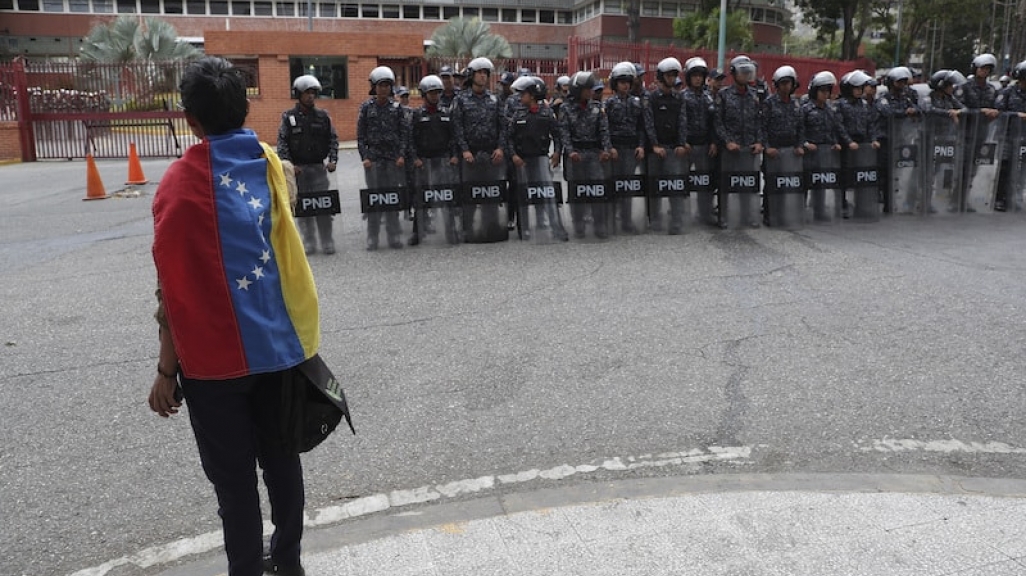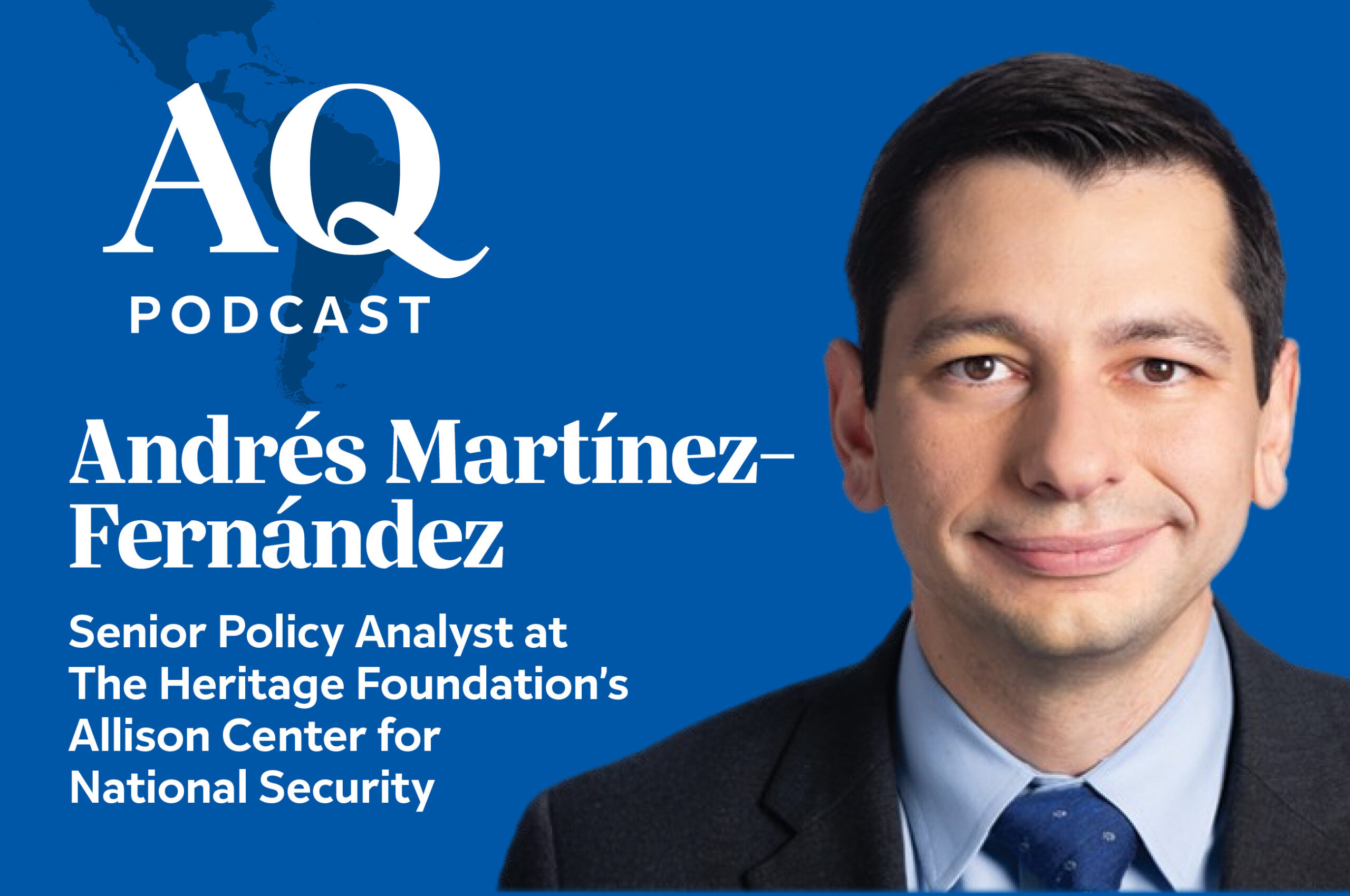Explainer: Armed Groups in Venezuela
Explainer: Armed Groups in Venezuela
From civilian gangs to military intelligence police, Venezuelans are surrounded by myriad groups that could detain or use lethal force against them.
State security forces killed nearly 5,000 Venezuelans in 2017, or more than a quarter of all homicides that year. AS/COA Online offers a rundown of the various security forces and armed groups are detaining and repressing Venezuelan citizens.
The National Guard (GNB) and the National Police (PNB)
The GNB and the PNB are the two primary forces facing protestors in the streets. The National Guard was founded in 1937 to protect the internal security of the country and maintain public order, and was made a branch of the Armed Forces in 2007. As of 2017, it had an estimated 70,000 enlisted members of the total 160,000 across all four branches.
The PNB, meanwhile, is a federal force created by Hugo Chávez in 2008 as a “preventative police force,” separate from state and local ones. In 2017, the PNB had an estimated 26,000 officers. In June of that year, Nicolás Maduro said he wanted to add 20,000 more to the ranks of both the GNB and the PNB.
While the GNB and PNB deploy tactics like rubber bullets and tear gas against protestors, they are also equipped with anti-riot machinery. The footage of an armored vehicle driving over an anti-Maduro protestor on April 30 was of a GNB “rhinoceros” VN-4 vehicle, one of almost 200 purchased from a Chinese defense manufacturer NORINCO for the GNB. The GNB is also equipped with at least ten “bat” ABV-1 vehicles in 2012, named for the three-meter high “wings” that can be deployed on each side, effectively creating a barrier across large spaces like highways. With no other reported sales of these vehicles, they appear to be custom-made for the GNB, per Caracas Chronicles. To round out the NORINCO orders, Venezuela also purchased ten “whale” WTC-1, 2,400-gallon water cannon trucks in the company in 2014.
Since the summer of 2016, the GNB is also the branch of the military in charge of distributing the country’s scarce food imports. In December of that year, an Associated Press report said military members were essentially trafficking the food supplies.
Special Action Forces (FAES)
The FAES is the elite PNB unit that, typically clad in black and ski masks, tracks civilians down in their neighborhoods and homes, separate from other PNB forces tasked with public order. Maduro created the FAES during a wave of deadly protests in 2017 officially to “combat crime and terrorism,” though insiders say he feared he was losing loyalty among the sprawling armed forces, especially as inflation took its toll on troops’ regular salaries. Today, the 1,400-strong force is “little more than an extermination unit,” as Insight Crime puts it, with close to 700 confirmed assassinations in two years of existence.
The night before Juan Guaidó claimed Venezuela’s interim presidency at a rally in Caracas in January 2019, FAES units raided poor neighborhoods in Caracas—with agents firing on residents from armored vehicles and snipers from atop apartment buildings—to intimidate chavista backsliders from joining the upcoming rally.
Bolivarian National Intelligence Service (SEBIN)
On paper, the SEBIN would be most akin to the Federal Bureau of Investigation in the United States in that its original mission when SEBIN’s predecessor was established in 1969 was to protect the national security of the territory. Chávez established the agency in its current form in 2010, and today it is mostly known for domestic surveillance of citizens, developed under the guidance of Cuban intelligence services. Though the Cuban-Venezuelan relationship dates back decades, intelligence agents from Havana began to file among the ranks of Venezuelan intelligence agencies and armed forces after the failed coup attempt against Chávez in 2002. The partnership is thought to have intensified during the Maduro years, with reports of Venezuelan enlisted men and women and government officials under surveillance.
The SEBIN’s headquarters are in the Helicoide, a massive spiral building in downtown Caracas, originally built as a shopping mall in the late 1950s and since converted into clinic-like torture barracks. In 2019, the SEBIN escalated its systematic targeting of opposition figures, detaining Guaidó’s chief of staff Roberto Marrero, Congressman Gilber Caro, and National Assembly Vice President Edgar Zambrano, the last of whom SEBIN towed in his car to their headquarters after he refused to turn himself in. Marrero is being held in the Helicoide, while the whereabouts of Caro and Zambrano remain unknown.
But the SEBIN ranks are showing some major fissures. Agents guarding political prisoners Leopoldo López and Iván Simonovis ignored orders and allowed both to leave their house arrest. On the day López left house arrest, SEBIN Director General Manuel Cristopher Figuera defected from the ranks of chavismo, a move for which the United States revoked the individual sanctions it had placed on him.
Military counterintelligence police (DGCIM)
Though the Venezuelan military has had an intelligence unit since 1957, it made the pivot to counterintelligence in 2011, and the force now typically investigates armed forces or officials who break rank. In practice, citizens accused of espionage or treason are typically detained by the SEBIN, while the DGCIM tends to target enlisted military members suspected of similar crimes.
In March, an Air Force lieutenant and DGCIM defector testified and provided evidence to an OAS hearing on the torture practices employed at the Helicoide by both SEBIN and DGCIM officials, a testimony that could lead to international criminal charges for implicated officials. Chávez’s former head of military intelligence has said that the torture practices were implemented on Maduro’s orders.
Colectivos
If there is anywhere in Venezuela where the chavista ideology lives on, it’s the colectivos—paramilitary civilian groups who call themselves the “armed defense of the Bolivarian revolution.” They number around 100,000. Created by Chávez in 2002 and after the two attempts from the military and also the oil sector to remove him from the presidency, the original raison d’être behind colectivos is that they would reinforce the Bolivarian ideology among the public through community programs, but that quickly evolved into a literal defense as the neighborhood groups took up arms and started to resemble gangs.
While not officially sanctioned as an armed unit, Maduro is increasingly reliant and regularly calls on them to repress dissent.
National and transnational criminal groups
Though Venezuela has a territory twice the size of California, 94 percent of its citizens live in cities, making it one of the least densely populated countries in the world and leaving large essentially lawless swathes of territory ripe in which nonstate actors operate, including the Colombian ELN and some ex-FARC guerrillas, Hezbollah members, and local crime syndicates involved in drug trafficking and illegal mining. Additionally, a faction of officers and officials—known colloquially as the Cartel of the Suns for the stars on the epaulettes worn by GNB generals—is involved with or has ties to drug trafficking.
The groups often battle each other, putting civilians in the crosshairs of the conflict. Twelve massacres of gold miners in 2016 left 107 reported dead, and another event in October 2018 saw 16 miners killed. International Crisis Group reports that some towns in the vast Bolivar state in the south where much of the mining takes place are seeing murder rates of several hundred per 100,000 residents—even higher than the estimated 2018 national homicide rate of 81.4 per 100,000.









